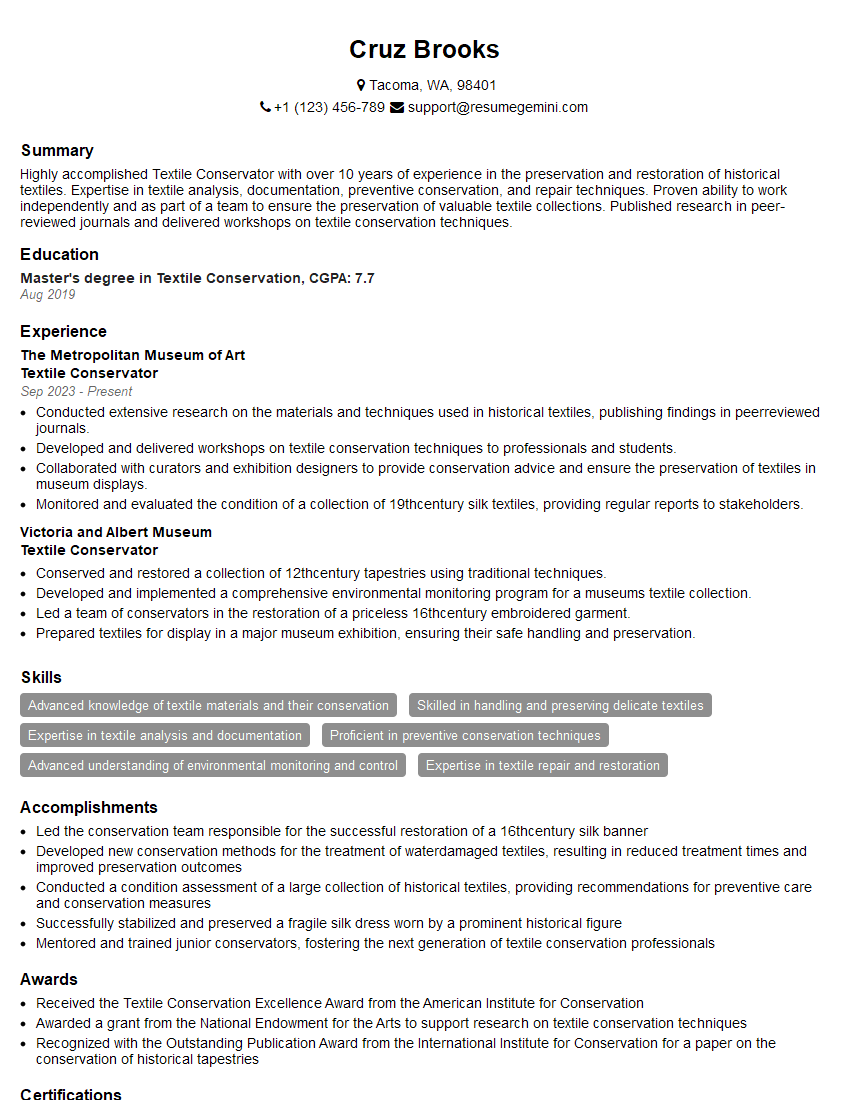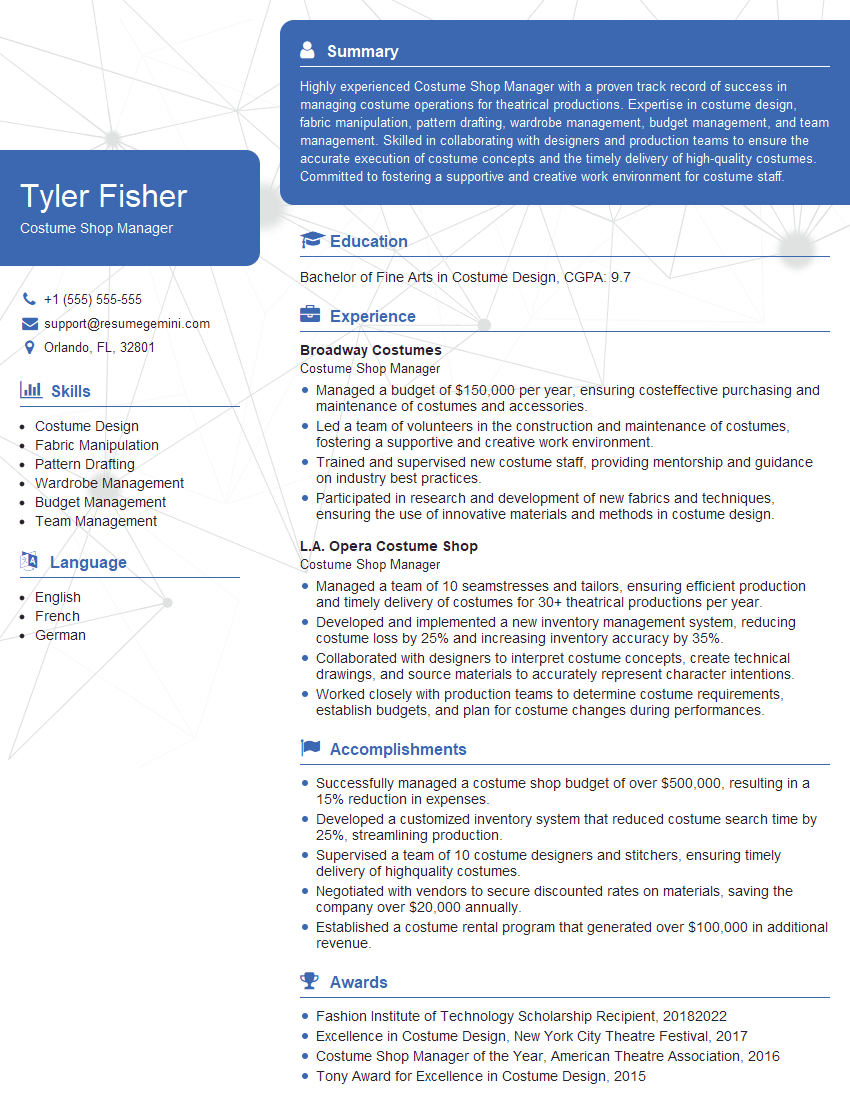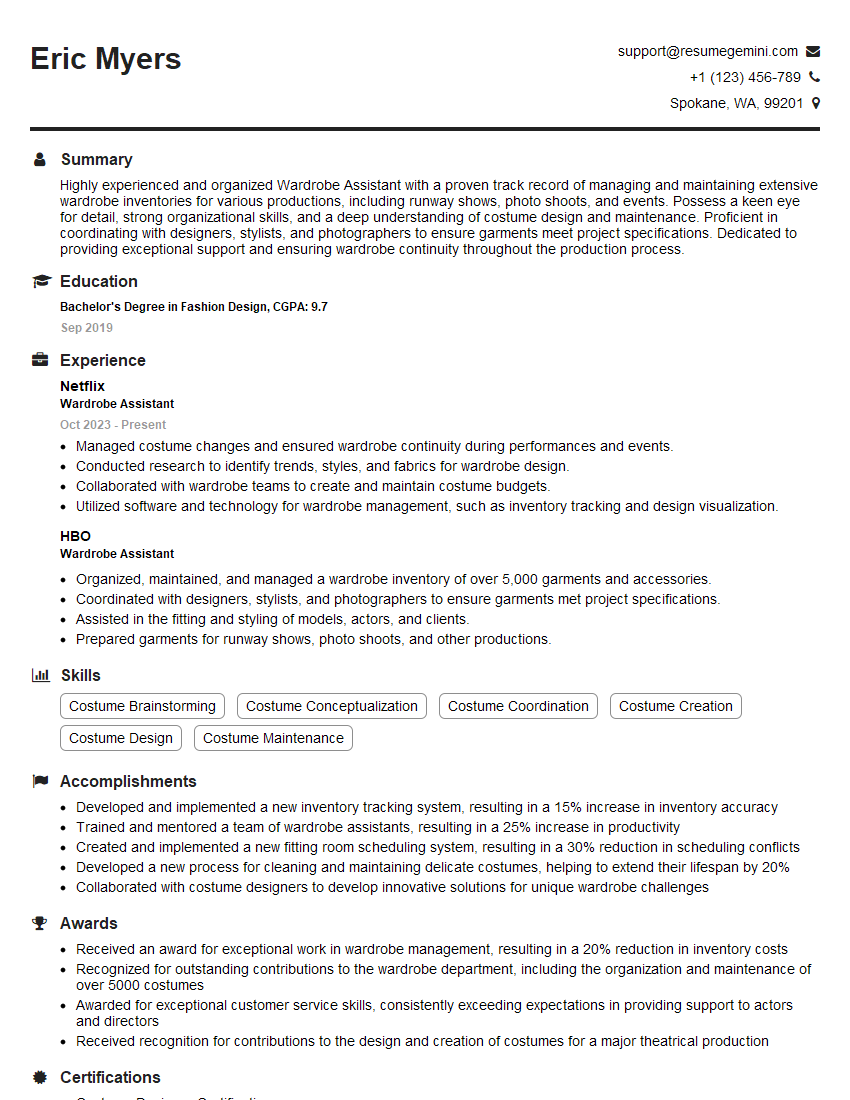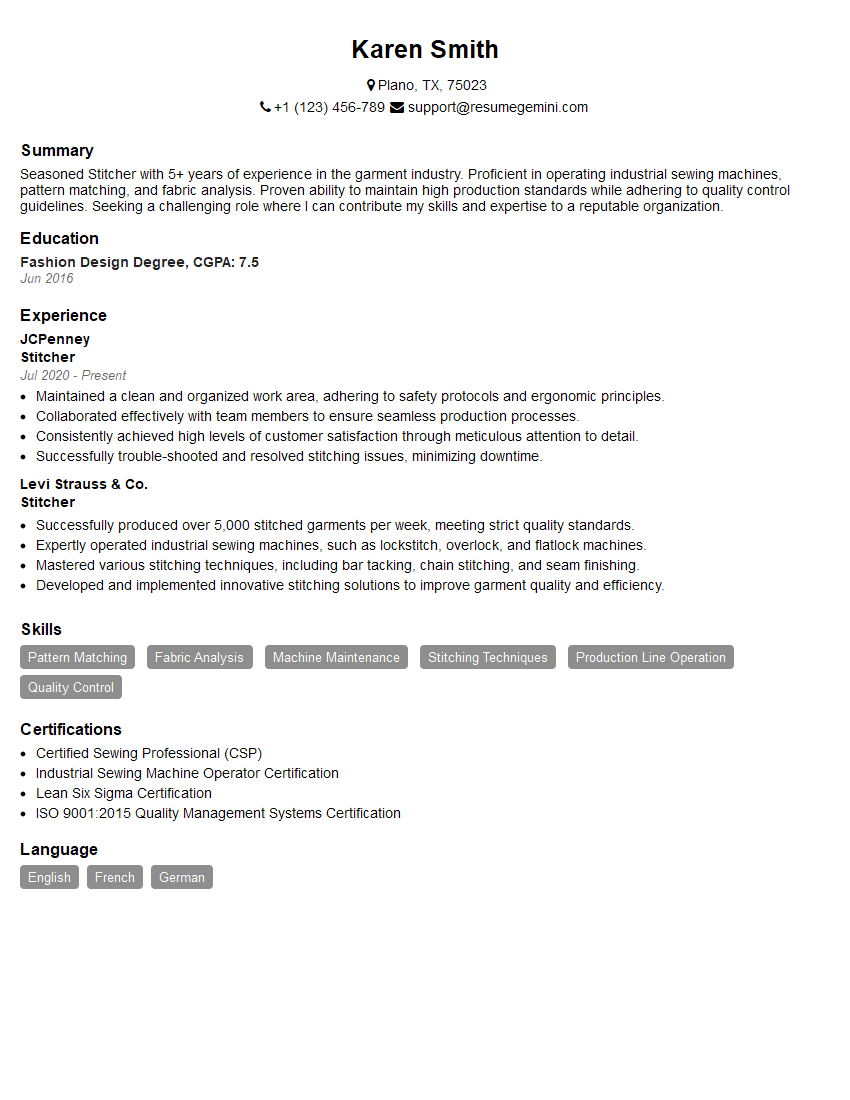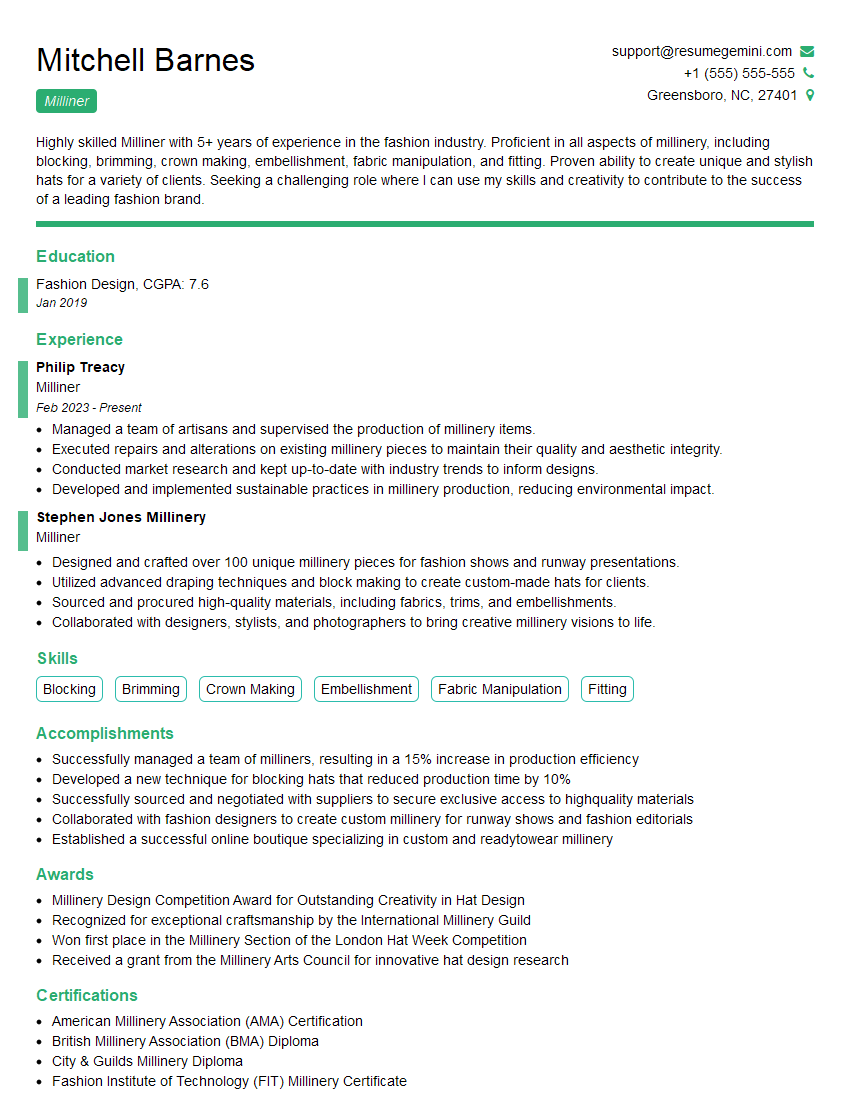The right preparation can turn an interview into an opportunity to showcase your expertise. This guide to Costume Maintenance and Repair interview questions is your ultimate resource, providing key insights and tips to help you ace your responses and stand out as a top candidate.
Questions Asked in Costume Maintenance and Repair Interview
Q 1. What are the common methods for cleaning delicate fabrics like silk and velvet?
Cleaning delicate fabrics like silk and velvet requires a gentle approach. Forget harsh chemicals and aggressive scrubbing! Instead, we prioritize dry cleaning or spot cleaning with specialized solutions. For dry cleaning, I always recommend a reputable professional who understands the nuances of these materials. For spot cleaning, I’d use a very small amount of mild detergent dissolved in cool water, testing it on an inconspicuous area first. The method involves gently dabbing (never rubbing!) the stain with a clean white cloth, working from the outside in to prevent spreading. Afterwards, blot the area dry with a clean, absorbent cloth and allow the fabric to air dry flat, away from direct sunlight or heat. Think of it like treating a precious heirloom – slow, careful, and methodical.
For example, a silk scarf with a wine stain would be treated with a dabbing motion using a solution of cool water and a tiny amount of baby shampoo. Velvet requires even more care; I might use a soft brush to gently lift the pile after cleaning to restore its plush texture. Never iron these fabrics directly – use a low-heat steam iron through a pressing cloth if absolutely necessary.
Q 2. Explain the process of repairing a seam rip on a period costume.
Repairing a seam rip on a period costume is a delicate process that demands precision and an understanding of historical sewing techniques. The first step is a careful assessment of the damage. This includes identifying the type of fabric, the nature of the rip (e.g., a simple tear versus a more complex unraveling), and the construction of the garment. For a simple rip, hand-sewing with a fine needle and thread that closely matches the original fabric is usually sufficient. I’d use a whip stitch or a ladder stitch, which are both nearly invisible. These stitches are often used in period costumes, ensuring the repair is historically accurate and blends seamlessly with the original construction. If the rip is more extensive or involves more complex seams, I may need to carefully unpick portions of the seam, repair the damaged fabric, and then resew it accurately.
For instance, mending a ripped seam on a 19th-century gown would involve using linen thread and a whip stitch to mirror the original construction. Matching the thread color and stitch type are crucial to maintain the garment’s historical integrity and avoid visible repairs.
Q 3. How do you identify and address common fabric damage such as moth holes or stains?
Identifying and addressing fabric damage begins with a thorough inspection. Moth holes are easily recognized as small, often irregular, holes in the fabric. Treatment includes carefully removing any remaining moth larvae or eggs before cleaning. For small holes, I use a technique called ‘darning’ which involves weaving new threads into the existing fabric to invisibly repair the damaged area. For larger holes, I might use a fabric patch applied from the inside or a strategically placed embellishment to conceal it.
Stains require careful identification and treatment depending on their type and the fabric’s composition. I always test any cleaning solution on an inconspicuous area first. Water-based stains are frequently addressed using gentle methods, as described earlier. Oil-based stains might require a specialized solvent. For stubborn stains or those on delicate fabrics, professional dry cleaning is always a safe option. A careful approach is key; patience and understanding of different fabric types and stain compositions are crucial to prevent further damage.
Q 4. What are your preferred methods for repairing tears in leather or faux leather?
Repairing tears in leather or faux leather depends heavily on the material’s thickness and the size of the tear. For small tears in thicker leather, I often use a leather patching technique, using a piece of leather that closely matches the original in color and texture. I’d apply a high-quality leather adhesive, ensuring a firm bond. For larger tears, a more complex repair might be necessary, possibly involving stitching the edges together with specialized leather thread and a saddle stitch to maximize durability. Faux leather, being synthetic, presents different challenges. I often use a strong fabric adhesive and might reinforce the repair with a backing patch.
For example, a tear in a leather jacket would likely be mended using a leather patch and strong adhesive, then carefully stitched with a saddle stitch to strengthen the repair. A tear in a faux leather handbag might be addressed differently; a fabric adhesive, a backing patch, and possibly a decorative stitch are employed to repair the damage aesthetically and structurally.
Q 5. Describe your experience with replacing zippers and buttons on various garments.
Replacing zippers and buttons is a common task that requires attention to detail and the right tools. The process for zippers starts with carefully removing the old zipper, taking care not to damage the surrounding fabric. The new zipper’s length and type should be carefully selected to match the garment. Then, I’ll re-sew the new zipper, paying close attention to even stitching and proper alignment. For buttons, I first determine the type of button (e.g., shank button, four-hole button) and then either sew it on by hand or by using a sewing machine. For more delicate fabrics, hand-sewing provides better control and minimizes fabric stress.
For example, replacing the zipper on a vintage dress would require selecting a compatible zipper, carefully removing the old one, and neatly sewing in the replacement using even stitches to keep the garment’s aesthetics intact. Similarly, replacing a button on a shirt would involve matching the thread to the button and the fabric for a neat and strong attachment.
Q 6. How do you handle the preservation and storage of costumes to prevent damage?
Preservation and storage are crucial for extending the life of costumes. I always begin by cleaning and mending any damages before storage. Then, the costumes are stored in acid-free tissue paper or acid-free muslin bags to prevent discoloration and deterioration. The garments should be stored flat whenever possible; hanging can stretch or damage the fibers. I also make sure that the storage area is cool, dark, dry, and well-ventilated to prevent pest infestations and mold growth. Acid-free boxes provide additional protection against environmental factors. Periodic inspection is also critical to detect any signs of damage or pest infestation at an early stage.
For example, a delicate Victorian-era gown would be stored flat within an acid-free box lined with acid-free tissue paper, supported by acid-free stuffing to maintain its shape. Regular inspections would ensure that no pests damage it.
Q 7. What are the differences between hand-sewing and machine-sewing techniques relevant to costume repair?
Hand-sewing and machine-sewing each have unique applications in costume repair. Hand-sewing offers greater control and precision, particularly for delicate fabrics and intricate repairs. This allows for more customized stitches and greater flexibility. Invisible stitches, crucial for period costumes, are almost exclusively done by hand. Machine-sewing is ideal for faster repairs, especially for sturdy fabrics or large areas of seam work, offering consistency and speed. However, machine-sewing can be more challenging with delicate fabrics due to the risk of fabric damage from the needle or pressure.
In practice, I might hand-sew a delicate lace repair on a historical costume while using a machine to sew a lining for a more durable garment. The choice between hand-sewing and machine-sewing often depends on the fabric, the extent of the damage, and the desired level of precision.
Q 8. What types of adhesives and glues are suitable for costume repair?
Selecting the right adhesive is crucial for successful costume repair. The choice depends heavily on the materials being joined and the stress the repair needs to withstand. Avoid using anything too aggressive, as it can damage delicate fabrics or cause discoloration.
- Fabric Glue: For delicate fabrics like silk or chiffon, a high-quality fabric glue is ideal. Look for ones specifically designed for textiles and that are flexible after drying, allowing for movement.
- Hot Glue: Hot glue is useful for quick repairs and attaching embellishments, especially on heavier fabrics. However, be cautious as it can melt synthetic fabrics or leave visible marks. Always test in an inconspicuous area first.
- Textile Adhesive Spray: Convenient for larger areas, but make sure it’s compatible with the fabric. Over-spraying can lead to stiffening, so less is more.
- Resin-based adhesives (epoxies): These are incredibly strong but can be less flexible. Use them judiciously for repairs requiring significant strength, like broken plastic parts on accessories. Proper ventilation is essential when working with epoxies.
For example, I once had to repair a delicate lace appliqué on a vintage gown. Fabric glue was the perfect choice – it bonded the lace seamlessly without leaving any residue.
Q 9. How do you choose the appropriate thread and needle for different fabrics?
Thread and needle selection depends entirely on the fabric’s weight, weave, and fiber content. Choosing the wrong combination can lead to puckering, broken threads, or damage to the fabric.
- Lightweight fabrics (silk, chiffon): Require fine needles (size 70/10 or smaller) and lightweight, high-quality thread (silk or cotton thread in a matching color).
- Medium-weight fabrics (cotton, linen): Can use needles size 80/12 or 90/14 and medium-weight thread (cotton, polyester, or a blend).
- Heavyweight fabrics (denim, canvas): Need thicker needles (size 100/16 or larger) and strong thread (heavy-duty polyester or nylon thread).
Think of it like this: a delicate fabric is like a fine piece of china – you wouldn’t use a sledgehammer to repair it! Similarly, using a thick needle on silk would cause holes. Always test your thread and needle combination on a scrap piece of the fabric before starting the repair.
Q 10. How would you address a broken clasp on a jewelry piece used as a costume accessory?
Repairing a broken clasp on costume jewelry requires careful assessment of the damage and the type of clasp. The materials of the clasp and jewelry will dictate the best repair method.
- Simple Replacement: If the clasp is easily replaceable (like a simple hook and eye), sourcing a matching replacement is the easiest solution. Consider visiting a jewelry supply store for options.
- Soldering (for metal clasps): For metal clasps, soldering might be necessary if the break is within the clasp itself. This requires specialized tools and some skill, so seeking a professional jeweler’s assistance is recommended, especially for delicate or valuable pieces.
- Adhesive Repair (for non-metal clasps): For non-metal clasps (e.g., plastic or resin), a strong adhesive might suffice. However, test the adhesive on a hidden area first to ensure it won’t discolor or damage the material. Ensure it is a flexible adhesive to account for movement.
Once repaired, always test the clasp’s functionality to ensure it’s secure and will withstand the movements of the performer during the show.
Q 11. Describe your experience working with various types of embellishments like beads and sequins.
My experience with embellishments like beads and sequins spans various techniques, from hand-sewing to machine application. Each type requires a different approach to ensure durability and a professional finish.
- Hand-sewing: For delicate work or intricate patterns, hand-sewing provides the most control and precision. I often use a beading needle and appropriate thread for secure attachment.
- Machine sewing: For larger quantities of beads or sequins, a sewing machine with a special beading foot can speed up the process. However, careful selection of needle and thread is crucial to avoid damage to the embellishments. Using a zig zag stitch can help secure beads in place without damaging them.
- Adhesive application: For temporary applications or smaller embellishments, fabric glue can be effective, ensuring proper ventilation.
For example, I once worked on a costume that required thousands of tiny sequins to be applied. Using a combination of machine sewing for larger sections and hand sewing for intricate areas ensured a high-quality, time-efficient result. The key is planning and preparation, especially for large scale projects.
Q 12. What are some common challenges encountered in maintaining historical costumes?
Maintaining historical costumes presents unique challenges because of the age and fragility of the materials. Many traditional fabrics are delicate and susceptible to damage from light, humidity, and handling.
- Fabric Degradation: Over time, fabrics can weaken, fade, and become brittle. Careful handling, appropriate storage conditions (cool, dark, and dry), and periodic cleaning by a specialist are crucial.
- Pest Infestation: Historical costumes are vulnerable to insect damage. Regular inspections and professional pest control are essential to prevent infestations.
- Environmental Factors: Exposure to sunlight, humidity, and temperature fluctuations can accelerate fabric deterioration. Proper storage and controlled environmental conditions are key.
- Repairing Damaged Materials: Sourcing replacement fabrics and threads that match the original can be extremely difficult, often requiring extensive research and specialist suppliers.
Imagine working with a costume from the 18th century – the fabric might be incredibly fragile. Careful handling, expert cleaning, and meticulous repairs are needed to preserve it for future generations.
Q 13. What safety precautions do you prioritize when working with specialized sewing machines or tools?
Safety is paramount when working with sewing machines and other tools. Ignoring safety precautions can lead to serious injuries.
- Machine Safety: Always ensure the sewing machine is properly grounded. Keep fingers clear of the needle and moving parts. Use appropriate safety guards and never operate the machine if it’s malfunctioning.
- Needle Safety: Handle needles with care to avoid pricking yourself. Use a needle minder or a magnetic needle holder to keep track of needles when not in use. Dispose of used needles safely in a designated container.
- Tool Safety: When using tools like scissors, rotary cutters, or iron, pay attention to the blades, which can be extremely sharp. Use appropriate safety measures with such tools, such as cut-resistant gloves.
- Personal Protective Equipment (PPE): Consider using eye protection to prevent injuries from flying threads or debris.
For example, I always ensure my sewing machine is properly plugged in and grounded, and I never attempt repairs while tired or distracted. A stitch in time saves nine, but safety should always come first.
Q 14. How do you handle the alteration of a costume to fit a specific performer?
Altering a costume to fit a specific performer requires precision and an understanding of both the garment’s construction and the performer’s measurements. Rushing this process can lead to irreversible damage or an ill-fitting costume.
- Accurate Measurements: Start with precise measurements of the performer, including height, chest, waist, hips, and inseam (where applicable).
- Pattern Adjustment: If a pattern is being used, adjust the pattern pieces to match the performer’s measurements before cutting the fabric.
- Seam Adjustments: Alterations can involve letting out seams, taking in seams, or adjusting the length of the garment.
- Fabric Considerations: Be mindful of the fabric’s drape and stretch when making alterations. Some fabrics are more forgiving than others.
- Trial fitting: Before finalizing alterations, a trial fitting is crucial to check fit and make any necessary adjustments.
Once, I had to alter a historical ball gown for a performer who was significantly shorter than the original wearer. This involved shortening the bodice, skirt and sleeves while maintaining the integrity of the original design. It was a challenging but rewarding project!
Q 15. What is your experience with working with different costume materials such as lace, fur, or brocade?
My experience working with diverse costume materials is extensive. I’ve handled everything from delicate lace, requiring incredibly gentle cleaning and repair techniques, to robust brocades, where I’ve learned to expertly mend tears and reinforce weakened areas using period-appropriate methods. Fur presents its own unique set of challenges, including cleaning, mothproofing, and repair of damaged pelts. I understand the specific needs of each fabric—the drape of silk, the texture of velvet, the fragility of antique textiles. For example, I once repaired a 1920s flapper dress with intricate lace detailing. The lace had suffered significant damage, but by using painstaking needlework and invisible mending techniques, I restored it to its original glory. This required a deep understanding of lace construction and the use of appropriate threads and dyes. Similarly, I’ve worked with heavy brocades on historical costumes, requiring the use of strong yet flexible stitching techniques that are structurally sound and historically accurate.
Career Expert Tips:
- Ace those interviews! Prepare effectively by reviewing the Top 50 Most Common Interview Questions on ResumeGemini.
- Navigate your job search with confidence! Explore a wide range of Career Tips on ResumeGemini. Learn about common challenges and recommendations to overcome them.
- Craft the perfect resume! Master the Art of Resume Writing with ResumeGemini’s guide. Showcase your unique qualifications and achievements effectively.
- Don’t miss out on holiday savings! Build your dream resume with ResumeGemini’s ATS optimized templates.
Q 16. Describe your experience with pattern making and alterations.
Pattern making and alterations are fundamental to my work. I’m proficient in drafting patterns from scratch, adapting existing patterns, and making alterations to ensure a perfect fit and silhouette. My experience ranges from simple adjustments like taking in seams to complex alterations involving reshaping garments entirely. I use a combination of traditional techniques and modern tools. For instance, I might use a digital pattern-making program to create a base pattern and then adjust it manually to ensure a precise fit for a client’s body type. I’m also skilled at grading patterns to accommodate different sizes. A recent project involved creating a completely new bodice pattern for a historical reproduction garment. The original pattern was lost, and I had to reconstruct it based on surviving photos and existing garment measurements. I relied on my knowledge of historical tailoring techniques to create a structurally sound and historically accurate garment.
Q 17. How do you assess the structural integrity of a costume before and after repair?
Assessing the structural integrity of a costume involves a meticulous process before and after any repair. Before starting work, I carefully examine the garment for any signs of damage, such as tears, holes, weakened seams, or fabric degradation. I check for issues like moth damage, rot, or staining. I feel the fabric to gauge its strength and identify any brittle or fragile areas. This initial assessment dictates the repair strategy. After the repair, I re-evaluate the garment’s structural integrity by testing the strength of the seams, checking for any distortions in the shape or drape of the fabric, and verifying that the repair blends seamlessly with the original material. Think of it like a structural engineer inspecting a building—every component must be assessed and ensured to meet standards. For example, when repairing a heavily damaged Victorian-era gown, I examined each seam, carefully noting the type of stitch and the condition of the thread. This informed the decision to use a matching stitch and thread for the repair. After the repair, I checked the garment’s drape and ensured that the repair didn’t cause any unwanted tension or distortion.
Q 18. What are your techniques for pressing and steaming various fabrics?
Pressing and steaming are essential for maintaining the appearance and structural integrity of costumes. My technique varies depending on the fabric. For delicate fabrics like silk or lace, I use a low temperature and a pressing cloth to prevent scorching. Heavier fabrics, like wool or brocade, can tolerate higher temperatures. Steaming is particularly useful for removing wrinkles from delicate materials without direct heat. I always test any heat treatment on an inconspicuous area first to ensure that it won’t cause damage. For example, when pressing a velvet garment, I use a low temperature and a pressing cloth to avoid flattening the pile. I also use different types of pressing tools, such as tailor’s ham or sleeve board, to achieve precise results, shaping the garment as I press.
Q 19. How familiar are you with different dyeing techniques for costumes?
I’m familiar with various dyeing techniques for costumes, ranging from traditional methods to modern techniques. I understand the properties of different dyes and how they interact with various fabrics. This includes natural dyes, fiber reactive dyes, and acid dyes. Choosing the correct dye and technique is crucial to achieving the desired color and avoiding damage to the fabric. I’m also mindful of the historical accuracy of dyes when working with period costumes. For example, if I’m restoring a 17th-century gown, I would avoid using modern dyes and try to match the original colors using natural dyes, creating a historically accurate representation. Safety is paramount, so I always work in a well-ventilated area and follow all safety precautions when handling dyes.
Q 20. What is your experience with cleaning and restoring antique or vintage costumes?
Cleaning and restoring antique or vintage costumes requires specialized knowledge and extreme care. I approach each piece with respect for its age and fragility. The cleaning process often begins with a thorough visual inspection to identify any damage or fragile areas. The cleaning method is determined by the fabric’s composition and the type of soiling. Some items may require professional dry cleaning, while others can be gently cleaned by hand. I use specialized cleaning solutions and tools to prevent damage. Moth damage is a common problem, and I address this with appropriate treatments. Repairing antique costumes requires a delicate hand and precise stitching to maintain historical integrity. I always prioritize preservation over drastic alterations. One memorable project involved the restoration of a mid-19th century wedding gown. It was fragile and heavily soiled. I used a conservation-grade cleaning method and carefully repaired several small tears using period-appropriate stitching techniques, preserving the delicate lace and embroidery.
Q 21. Explain your process for documenting repair work for record-keeping.
Documenting repair work is critical for record-keeping and future reference. My process involves a detailed written record of the garment’s condition before and after repair, including photographic documentation. This record includes a description of the garment, the type of damage, the materials used in the repair, and a step-by-step account of the process. Digital photography is essential for capturing the details of any damage before and after restoration. I also maintain a detailed inventory of materials used, including dye lots and thread types. This is important for future maintenance or repairs. This level of documentation is essential for tracking the history of the garment and to assist others who might work on the costume in the future. This comprehensive approach ensures the historical and aesthetic integrity of the piece is preserved.
Q 22. How do you handle urgent costume repairs under pressure?
Handling urgent costume repairs under pressure requires a calm, methodical approach. Think of it like a surgical team – quick, precise actions are key, but so is staying focused. First, I assess the damage quickly, prioritizing the most critical repairs that impact the performance. This might involve a quick seam mend, a button replacement, or a snag repaired with invisible stitches. I prioritize speed without compromising quality, using appropriate techniques for the fabric and time constraint. For example, if a major tear occurs just before a scene, I might use temporary adhesive tape to hold it together while simultaneously making a more permanent repair backstage. After addressing the immediate problem, I document the repair for later more thorough attention if needed, ensuring the costume remains stage-ready.
I also rely on efficient tools – a well-stocked sewing kit with essential needles, thread, and repair materials is crucial. Having a pre-prepared emergency kit readily available saves vital minutes.
Q 23. What are your methods for managing a large volume of costumes for a production?
Managing a large volume of costumes requires meticulous organization and a robust system. Imagine a library, but for clothing! I begin by creating a comprehensive inventory database, cataloging each costume with detailed information – including fabric type, measurements, unique identifiers, and any previous repairs. This database is crucial for tracking costumes throughout the production process. Then, I establish a clear labeling system for costumes, using barcodes or RFID tags where possible to streamline the process. A well-defined storage system is also paramount; we may use hanging racks, garment bags, and specialized storage containers optimized for the costumes’ delicate nature. Regular inspections are key to prevent damage and identify potential issues proactively. Each costume’s condition and current location are always monitored.
Q 24. Describe your experience with collaborating with designers, actors, and other members of a production team.
Collaboration is the lifeblood of successful productions. My experience involves actively working with costume designers to understand their vision and translate it into practical, maintainable costumes. I translate their artistic aspirations into durable, performance-ready garments. With actors, open communication is essential to ensure the costumes are comfortable and fit properly. This includes making adjustments during fittings and addressing concerns actors might have regarding movement or comfort. Collaborating with other members of the production team, such as stagehands and lighting technicians, is also crucial. For example, understanding the lighting design can influence fabric choices to avoid unwanted reflections, and a conversation with stagehands about delicate costume pieces helps ensure they are handled with care. This collaborative approach ensures that the costumes not only look fantastic but also perform flawlessly.
Q 25. What are the environmental considerations for storing and maintaining costumes?
Environmental considerations are vital for preserving the longevity and quality of costumes. Think of it like preserving precious artwork. Temperature and humidity are key factors; costumes should be stored in a cool, dry, and well-ventilated area to prevent mold, mildew, and damage from temperature fluctuations. Direct sunlight should be avoided, as UV rays can fade colors and damage fabrics. Proper pest control is also essential to prevent damage from insects. Ideally, costumes should be stored in acid-free archival-quality boxes or garment bags to protect them from dust, light, and pollutants. Regular inspections are also necessary to identify and address any environmental issues promptly. Using climate control systems like dehumidifiers or specialized storage units can also be crucial to maintaining stable conditions, especially for sensitive fabrics.
Q 26. How do you manage inventory and track repairs of costumes?
Inventory management and repair tracking are intertwined processes. I use a combination of physical and digital methods. A detailed inventory database, as previously mentioned, is my cornerstone, with each costume assigned a unique ID. This database tracks the location, condition, and any previous repairs or alterations. For physical tracking, I utilize barcodes or RFID tags, enabling quick scanning and accurate record-keeping. A detailed repair log is maintained, documenting every intervention. It includes the date of repair, the nature of the damage, the materials used, and the cost (if applicable). This method enables us to keep meticulous track of repairs, predict maintenance needs, and manage the overall lifecycle of each costume effectively. It’s essential to create a system that suits the size and complexity of the collection.
Q 27. What software or technology are you familiar with for managing costume details?
I’m proficient in several software applications that enhance costume management. FileMaker Pro, for example, is fantastic for creating robust databases with custom fields to track specific details about each costume. Spreadsheet software like Microsoft Excel or Google Sheets can also be used effectively for simpler inventory systems. Dedicated costume management software exists, such as those offered by companies specializing in theatrical production software. These usually integrate with other production tools, simplifying workflows and ensuring efficient data management. My familiarity with various software options allows me to adapt to the specific needs of each production.
Q 28. How do you stay updated with the latest techniques and best practices in costume maintenance and repair?
Staying updated in this field requires continuous learning. I regularly attend workshops and conferences focusing on costume preservation and repair techniques. Trade publications and professional organizations, such as the Costume Society of America, offer invaluable resources. Online forums and communities are great for sharing knowledge and staying abreast of the latest industry trends. Experimentation is also vital; I consistently explore new materials and techniques, while always ensuring they meet the highest standards of conservation and preservation. This constant learning ensures I remain at the forefront of the field, delivering the best possible care for the costumes in my charge.
Key Topics to Learn for Costume Maintenance and Repair Interview
- Fabric Identification and Properties: Understanding different fabric types (silk, cotton, wool, synthetics), their strengths, weaknesses, and appropriate cleaning/repair methods. Practical application: Identifying a damaged fabric and selecting the correct repair technique.
- Seam Repair Techniques: Mastering various hand-sewing and machine-sewing techniques for mending tears, reinforcing seams, and creating invisible repairs. Practical application: Repairing a ripped seam on a delicate historical garment.
- Stain Removal and Cleaning: Knowledge of various stain removal methods, appropriate cleaning solutions for different fabrics, and understanding the importance of pre-treating stains. Practical application: Removing a grease stain from a velvet costume without damaging the fabric.
- Pattern Making and Alterations: Basic pattern making skills to create patches or adjustments to costumes. Understanding of alteration techniques to fit costumes to different body types. Practical application: Creating a patch for a hole in a period costume, maintaining the original aesthetic.
- Fastener Repair: Proficiency in repairing zippers, buttons, hooks, and eyes. Practical application: Replacing a broken zipper on a stage costume quickly and efficiently.
- Working with Special Materials: Experience with handling delicate fabrics (lace, beading, embroidery), leather, fur, and other specialized materials commonly used in costumes. Practical application: Repairing a damaged beaded garment without losing beads or damaging the embroidery.
- Costume Construction Knowledge: Understanding the basic construction techniques used in costume making to better diagnose and repair issues. Practical application: Identifying why a particular seam is failing and implementing a preventative measure.
- Safety and Hygiene Practices: Adhering to safety protocols in the workshop, proper handling of cleaning agents, and maintaining a clean and organized work space. Practical application: Safely using a sewing machine and disposing of hazardous materials.
- Problem-solving and Troubleshooting: Ability to assess a damaged garment, identify the problem, and develop a practical solution to restore the costume to its original condition or a suitable state for performance. Practical application: Repairing a complex tear in a costume while adhering to deadlines.
Next Steps
Mastering Costume Maintenance and Repair opens doors to exciting career opportunities in theatre, film, television, museums, and more. Building a strong, ATS-friendly resume is crucial for showcasing your skills and experience to potential employers. ResumeGemini is a trusted resource to help you craft a compelling and effective resume that highlights your unique abilities. We provide examples of resumes tailored to Costume Maintenance and Repair professionals, ensuring your application stands out from the competition. Take the next step towards your dream career today!
Explore more articles
Users Rating of Our Blogs
Share Your Experience
We value your feedback! Please rate our content and share your thoughts (optional).
What Readers Say About Our Blog
Hello,
We found issues with your domain’s email setup that may be sending your messages to spam or blocking them completely. InboxShield Mini shows you how to fix it in minutes — no tech skills required.
Scan your domain now for details: https://inboxshield-mini.com/
— Adam @ InboxShield Mini
Reply STOP to unsubscribe
Hi, are you owner of interviewgemini.com? What if I told you I could help you find extra time in your schedule, reconnect with leads you didn’t even realize you missed, and bring in more “I want to work with you” conversations, without increasing your ad spend or hiring a full-time employee?
All with a flexible, budget-friendly service that could easily pay for itself. Sounds good?
Would it be nice to jump on a quick 10-minute call so I can show you exactly how we make this work?
Best,
Hapei
Marketing Director
Hey, I know you’re the owner of interviewgemini.com. I’ll be quick.
Fundraising for your business is tough and time-consuming. We make it easier by guaranteeing two private investor meetings each month, for six months. No demos, no pitch events – just direct introductions to active investors matched to your startup.
If youR17;re raising, this could help you build real momentum. Want me to send more info?
Hi, I represent an SEO company that specialises in getting you AI citations and higher rankings on Google. I’d like to offer you a 100% free SEO audit for your website. Would you be interested?
Hi, I represent an SEO company that specialises in getting you AI citations and higher rankings on Google. I’d like to offer you a 100% free SEO audit for your website. Would you be interested?
good
